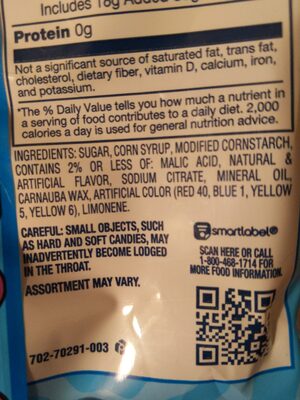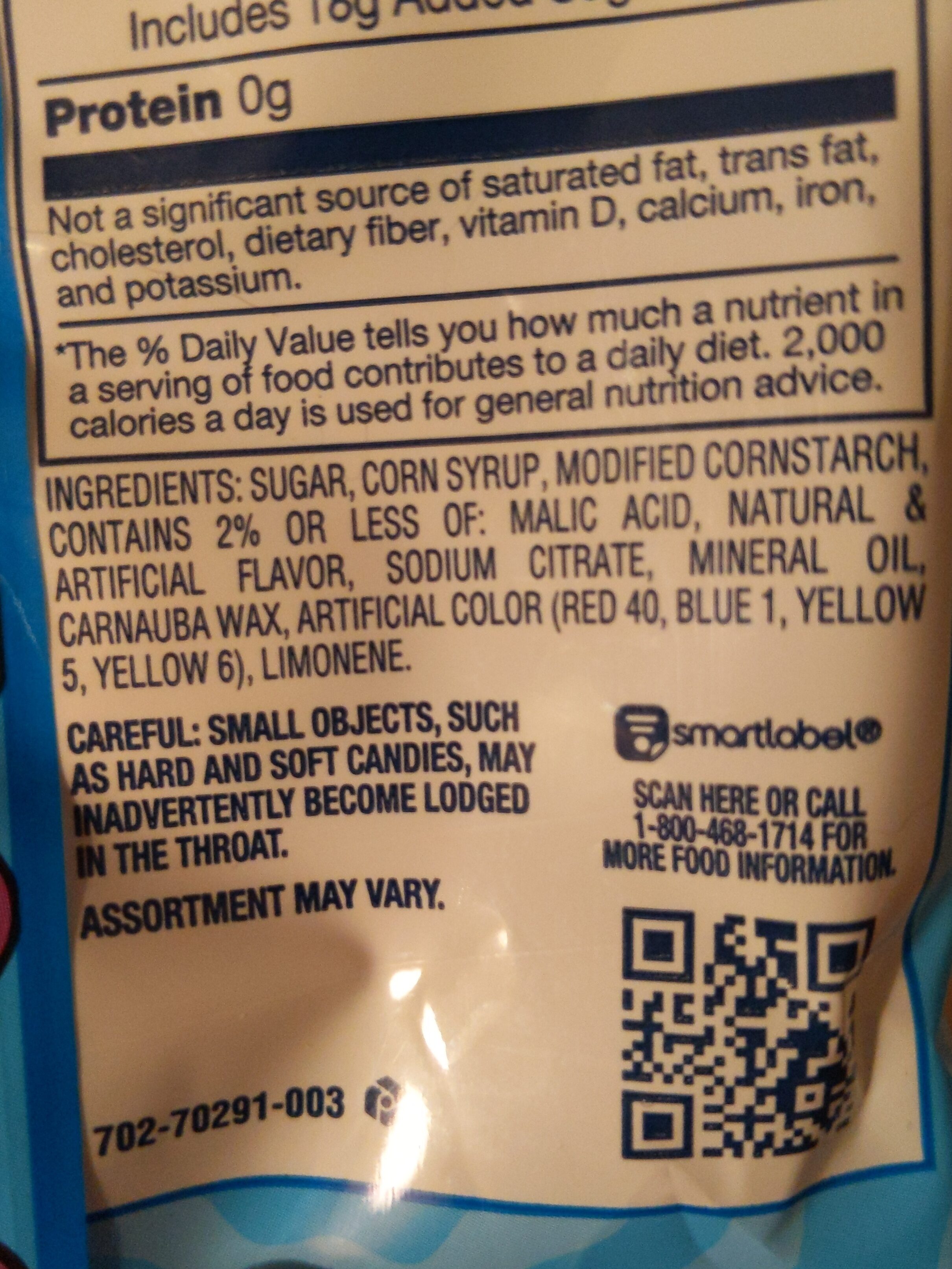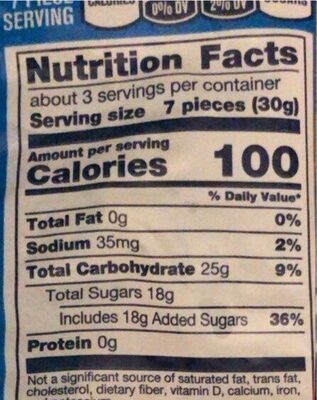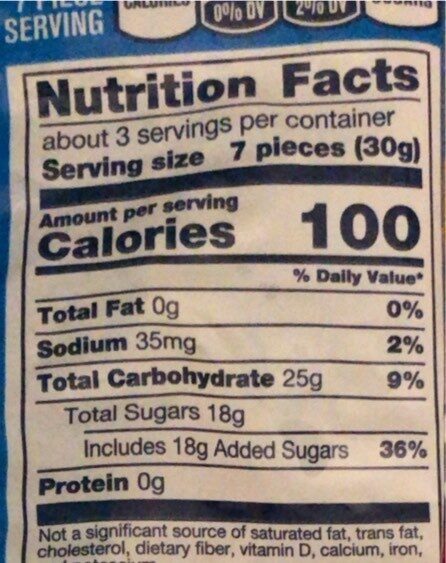Help us make food transparency the norm!
As a non-profit organization, we depend on your donations to continue informing consumers around the world about what they eat.
The food revolution starts with you!
jolly rancher gummies
jolly rancher gummies
This product page is not complete. You can help to complete it by editing it and adding more data from the photos we have, or by taking more photos using the app for Android or iPhone/iPad. Thank you!
×
Barcode: 0010700702913 (EAN / EAN-13) 010700702913 (UPC / UPC-A)
Categories: Snacks, Sweet snacks, Confectioneries, Candies
Labels, certifications, awards: Vegetarian
Countries where sold: United States
Matching with your preferences
Health
Ingredients
-
22 ingredients
SUGAR, CORN SYRUP, MODIFIED CORNSTARCH, CONTAINS 2% OR LESS OF: MALIC ACID, NATURAL & ARTIFICIAL FLAVOR, SODIUM CITRATE, MINERAL OIL, CARNAUBA WAX, ARTIFICIAL COLOR (RED 40, BLUE 1, YELLOW 5, YELLOW 6), LIMONENE. CAREFUL: SMALL OBJECTS, SUCH AS HARD AND SOFT CANDIES, MAY INADVERTENTLY BECOME LODGED IN THE THROAT. smartlabel® SCAN HERE OR CALL 1-800-468-1714 FOR MORE FOOD INFORMATION. ASSORTMENT MAY VARY. 702-70291-003
Food processing
-
Ultra processed foods
Elements that indicate the product is in the 4 - Ultra processed food and drink products group:
- Additive: E102 - Tartrazine
- Additive: E110 - Sunset yellow FCF
- Additive: E129 - Allura red
- Additive: E133 - Brilliant blue FCF
- Additive: E903 - Carnauba wax
- Additive: E905 - Synthetic wax
- Ingredient: Colour
- Ingredient: Flavouring
Food products are classified into 4 groups according to their degree of processing:
- Unprocessed or minimally processed foods
- Processed culinary ingredients
- Processed foods
- Ultra processed foods
The determination of the group is based on the category of the product and on the ingredients it contains.
Additives
-
E102 - Tartrazine
Tartrazine: Tartrazine is a synthetic lemon yellow azo dye primarily used as a food coloring. It is also known as E number E102, C.I. 19140, FD&C Yellow 5, Acid Yellow 23, Food Yellow 4, and trisodium 1--4-sulfonatophenyl--4--4-sulfonatophenylazo--5-pyrazolone-3-carboxylate-.Tartrazine is a commonly used color all over the world, mainly for yellow, and can also be used with Brilliant Blue FCF -FD&C Blue 1, E133- or Green S -E142- to produce various green shades.Source: Wikipedia
-
E110 - Sunset yellow FCF
Sunset Yellow FCF: Sunset Yellow FCF -also known as Orange Yellow S, or C.I. 15985- is a petroleum-derived orange azo dye with a pH dependent maximum absorption at about 480 nm at pH 1 and 443 nm at pH 13 with a shoulder at 500 nm. When added to foods sold in the US it is known as FD&C Yellow 6; when sold in Europe, it is denoted by E Number E110.Source: Wikipedia
-
E129 - Allura red
Allura Red AC: Allura Red AC is a red azo dye that goes by several names, including FD&C Red 40. It is used as a food dye and has the E number E129. It is usually supplied as its red sodium salt, but can also be used as the calcium and potassium salts. These salts are soluble in water. In solution, its maximum absorbance lies at about 504 nm.Source: Wikipedia
-
E133 - Brilliant blue FCF
Brilliant Blue FCF: Brilliant Blue FCF -Blue 1- is an organic compound classified as a triarylmethane dye and a blue azo dye, reflecting its chemical structure. Known under various commercial names, it is a colorant for foods and other substances. It is denoted by E number E133 and has a color index of 42090. It has the appearance of a blue powder. It is soluble in water, and the solution has a maximum absorption at about 628 nanometers.Source: Wikipedia
-
E296 - Malic acid
Malic acid: Malic acid is an organic compound with the molecular formula C4H6O5. It is a dicarboxylic acid that is made by all living organisms, contributes to the pleasantly sour taste of fruits, and is used as a food additive. Malic acid has two stereoisomeric forms -L- and D-enantiomers-, though only the L-isomer exists naturally. The salts and esters of malic acid are known as malates. The malate anion is an intermediate in the citric acid cycle.Source: Wikipedia
-
E331 - Sodium citrates
Sodium citrate: Sodium citrate may refer to any of the sodium salts of citrate -though most commonly the third-: Monosodium citrate Disodium citrate Trisodium citrateThe three forms of the salt are collectively known by the E number E331. Sodium citrates are used as acidity regulators in food and drinks, and also as emulsifiers for oils. They enable cheeses to melt without becoming greasy.Source: Wikipedia
-
E903 - Carnauba wax
Carnauba wax: Carnauba -; Portuguese: carnaúba [kaʁnɐˈubɐ]-, also called Brazil wax and palm wax, is a wax of the leaves of the palm Copernicia prunifera -Synonym: Copernicia cerifera-, a plant native to and grown only in the northeastern Brazilian states of Piauí, Ceará, Maranhão, Bahia, and Rio Grande do Norte. It is known as "queen of waxes" and in its pure state, usually comes in the form of hard yellow-brown flakes. It is obtained from the leaves of the carnauba palm by collecting and drying them, beating them to loosen the wax, then refining and bleaching the wax.Source: Wikipedia
-
E905 - Synthetic wax
Microcrystalline wax: Microcrystalline waxes are a type of wax produced by de-oiling petrolatum, as part of the petroleum refining process. In contrast to the more familiar paraffin wax which contains mostly unbranched alkanes, microcrystalline wax contains a higher percentage of isoparaffinic -branched- hydrocarbons and naphthenic hydrocarbons. It is characterized by the fineness of its crystals in contrast to the larger crystal of paraffin wax. It consists of high molecular weight saturated aliphatic hydrocarbons. It is generally darker, more viscous, denser, tackier and more elastic than paraffin waxes, and has a higher molecular weight and melting point. The elastic and adhesive characteristics of microcrystalline waxes are related to the non-straight chain components which they contain. Typical microcrystalline wax crystal structure is small and thin, making them more flexible than paraffin wax. It is commonly used in cosmetic formulations. Microcrystalline waxes when produced by wax refiners are typically produced to meet a number of ASTM specifications. These include congeal point -ASTM D938-, needle penetration -D1321-, color -ASTM D6045-, and viscosity -ASTM D445-. Microcrystalline waxes can generally be put into two categories: "laminating" grades and "hardening" grades. The laminating grades typically have a melt point of 140-175 F -60 - 80 oC- and needle penetration of 25 or above. The hardening grades will range from about 175-200 F -80 - 93 oC-, and have a needle penetration of 25 or below. Color in both grades can range from brown to white, depending on the degree of processing done at the refinery level. Microcrystalline waxes are derived from the refining of the heavy distillates from lubricant oil production. This by-product must then be de-oiled at a wax refinery. Depending on the end use and desired specification, the product may then have its odor removed and color removed -which typically starts as a brown or dark yellow-. This is usually done by means of a filtration method or by hydro-treating the wax material.Source: Wikipedia
-
E905a - Mineral oil
Microcrystalline wax: Microcrystalline waxes are a type of wax produced by de-oiling petrolatum, as part of the petroleum refining process. In contrast to the more familiar paraffin wax which contains mostly unbranched alkanes, microcrystalline wax contains a higher percentage of isoparaffinic -branched- hydrocarbons and naphthenic hydrocarbons. It is characterized by the fineness of its crystals in contrast to the larger crystal of paraffin wax. It consists of high molecular weight saturated aliphatic hydrocarbons. It is generally darker, more viscous, denser, tackier and more elastic than paraffin waxes, and has a higher molecular weight and melting point. The elastic and adhesive characteristics of microcrystalline waxes are related to the non-straight chain components which they contain. Typical microcrystalline wax crystal structure is small and thin, making them more flexible than paraffin wax. It is commonly used in cosmetic formulations. Microcrystalline waxes when produced by wax refiners are typically produced to meet a number of ASTM specifications. These include congeal point -ASTM D938-, needle penetration -D1321-, color -ASTM D6045-, and viscosity -ASTM D445-. Microcrystalline waxes can generally be put into two categories: "laminating" grades and "hardening" grades. The laminating grades typically have a melt point of 140-175 F -60 - 80 oC- and needle penetration of 25 or above. The hardening grades will range from about 175-200 F -80 - 93 oC-, and have a needle penetration of 25 or below. Color in both grades can range from brown to white, depending on the degree of processing done at the refinery level. Microcrystalline waxes are derived from the refining of the heavy distillates from lubricant oil production. This by-product must then be de-oiled at a wax refinery. Depending on the end use and desired specification, the product may then have its odor removed and color removed -which typically starts as a brown or dark yellow-. This is usually done by means of a filtration method or by hydro-treating the wax material.Source: Wikipedia
Ingredients analysis
-
Palm oil content unknown
Unrecognized ingredients: Contains-2-and-less-of, Limonene, Careful, Small-objects, Such-as-hard-and-soft-candies, May-inadvertently-become-lodged-in-the-throat, Smartlabel-scan-here-and-call-1-800-468-1714-for-more-food-information, Assortment-may-vary, 702-70291-003Some ingredients could not be recognized.
We need your help!
You can help us recognize more ingredients and better analyze the list of ingredients for this product and others:
- Edit this product page to correct spelling mistakes in the ingredients list, and/or to remove ingredients in other languages and sentences that are not related to the ingredients.
- Add new entries, synonyms or translations to our multilingual lists of ingredients, ingredient processing methods, and labels.
If you would like to help, join the #ingredients channel on our Slack discussion space and/or learn about ingredients analysis on our wiki. Thank you!
-
Vegan status unknown
Unrecognized ingredients: Contains-2-and-less-of, Sodium citrate, Limonene, Careful, Small-objects, Such-as-hard-and-soft-candies, May-inadvertently-become-lodged-in-the-throat, Smartlabel-scan-here-and-call-1-800-468-1714-for-more-food-information, Assortment-may-vary, 702-70291-003Some ingredients could not be recognized.
We need your help!
You can help us recognize more ingredients and better analyze the list of ingredients for this product and others:
- Edit this product page to correct spelling mistakes in the ingredients list, and/or to remove ingredients in other languages and sentences that are not related to the ingredients.
- Add new entries, synonyms or translations to our multilingual lists of ingredients, ingredient processing methods, and labels.
If you would like to help, join the #ingredients channel on our Slack discussion space and/or learn about ingredients analysis on our wiki. Thank you!
-
Vegetarian
No non-vegetarian ingredients detected
Unrecognized ingredients: Contains-2-and-less-of, Sodium citrate, Limonene, Careful, Small-objects, Such-as-hard-and-soft-candies, May-inadvertently-become-lodged-in-the-throat, Smartlabel-scan-here-and-call-1-800-468-1714-for-more-food-information, Assortment-may-vary, 702-70291-003Some ingredients could not be recognized.
We need your help!
You can help us recognize more ingredients and better analyze the list of ingredients for this product and others:
- Edit this product page to correct spelling mistakes in the ingredients list, and/or to remove ingredients in other languages and sentences that are not related to the ingredients.
- Add new entries, synonyms or translations to our multilingual lists of ingredients, ingredient processing methods, and labels.
If you would like to help, join the #ingredients channel on our Slack discussion space and/or learn about ingredients analysis on our wiki. Thank you!
-
Details of the analysis of the ingredients
We need your help!
Some ingredients could not be recognized.
We need your help!
You can help us recognize more ingredients and better analyze the list of ingredients for this product and others:
- Edit this product page to correct spelling mistakes in the ingredients list, and/or to remove ingredients in other languages and sentences that are not related to the ingredients.
- Add new entries, synonyms or translations to our multilingual lists of ingredients, ingredient processing methods, and labels.
If you would like to help, join the #ingredients channel on our Slack discussion space and/or learn about ingredients analysis on our wiki. Thank you!
: SUGAR, CORN SYRUP, MODIFIED CORNSTARCH, CONTAINS 2% and LESS OF (MALIC ACID), NATURAL and ARTIFICIAL FLAVOR, SODIUM CITRATE, MINERAL OIL, CARNAUBA WAX, ARTIFICIAL COLOR (RED 40, BLUE 1, YELLOW 5, YELLOW 6), LIMONENE, CAREFUL (SMALL OBJECTS), SUCH AS HARD and SOFT CANDIES, MAY INADVERTENTLY BECOME LODGED IN THE THROAT, smartlabel® SCAN HERE and CALL 1-800-468-1714 FOR MORE FOOD INFORMATION, ASSORTMENT MAY VARY, 702-70291-003- SUGAR -> en:sugar - vegan: yes - vegetarian: yes - ciqual_proxy_food_code: 31016 - percent_min: 6.25 - percent_max: 100
- CORN SYRUP -> en:corn-syrup - vegan: yes - vegetarian: yes - ciqual_proxy_food_code: 31089 - percent_min: 0 - percent_max: 50
- MODIFIED CORNSTARCH -> en:modified-corn-starch - vegan: yes - vegetarian: yes - ciqual_food_code: 9510 - percent_min: 0 - percent_max: 33.3333333333333
- CONTAINS 2% and LESS OF -> en:contains-2-and-less-of - percent_min: 0 - percent_max: 25
- MALIC ACID -> en:e296 - vegan: yes - vegetarian: yes - percent_min: 0 - percent_max: 25
- NATURAL and ARTIFICIAL FLAVOR -> en:natural-and-artificial-flavouring - vegan: maybe - vegetarian: maybe - percent_min: 0 - percent_max: 5
- SODIUM CITRATE -> en:sodium-citrate - percent_min: 0 - percent_max: 5
- MINERAL OIL -> en:e905a - vegan: yes - vegetarian: yes - percent_min: 0 - percent_max: 5
- CARNAUBA WAX -> en:e903 - vegan: yes - vegetarian: yes - percent_min: 0 - percent_max: 5
- ARTIFICIAL COLOR -> en:colour - percent_min: 0 - percent_max: 5
- RED 40 -> en:e129 - vegan: yes - vegetarian: yes - percent_min: 0 - percent_max: 5
- BLUE 1 -> en:e133 - vegan: yes - vegetarian: yes - percent_min: 0 - percent_max: 2.5
- YELLOW 5 -> en:e102 - vegan: yes - vegetarian: yes - percent_min: 0 - percent_max: 1.66666666666667
- YELLOW 6 -> en:e110 - vegan: yes - vegetarian: yes - percent_min: 0 - percent_max: 1.25
- LIMONENE -> en:limonene - percent_min: 0 - percent_max: 5
- CAREFUL -> en:careful - percent_min: 0 - percent_max: 5
- SMALL OBJECTS -> en:small-objects - percent_min: 0 - percent_max: 5
- SUCH AS HARD and SOFT CANDIES -> en:such-as-hard-and-soft-candies - percent_min: 0 - percent_max: 5
- MAY INADVERTENTLY BECOME LODGED IN THE THROAT -> en:may-inadvertently-become-lodged-in-the-throat - percent_min: 0 - percent_max: 5
- smartlabel® SCAN HERE and CALL 1-800-468-1714 FOR MORE FOOD INFORMATION -> en:smartlabel-scan-here-and-call-1-800-468-1714-for-more-food-information - percent_min: 0 - percent_max: 5
- ASSORTMENT MAY VARY -> en:assortment-may-vary - percent_min: 0 - percent_max: 5
- 702-70291-003 -> en:702-70291-003 - percent_min: 0 - percent_max: 5
Nutrition
-
Poor nutritional quality
⚠ ️Warning: the amount of fiber is not specified, their possible positive contribution to the grade could not be taken into account.⚠ ️Warning: the amount of fruits, vegetables and nuts is not specified on the label, it was estimated from the list of ingredients: 0This product is not considered a beverage for the calculation of the Nutri-Score.
Positive points: 0
- Proteins: 0 / 5 (value: 0, rounded value: 0)
- Fiber: 0 / 5 (value: 0, rounded value: 0)
- Fruits, vegetables, nuts, and colza/walnut/olive oils: 0 / 5 (value: 0, rounded value: 0)
Negative points: 15
- Energy: 4 / 10 (value: 1395, rounded value: 1395)
- Sugars: 10 / 10 (value: 60, rounded value: 60)
- Saturated fat: 0 / 10 (value: 0, rounded value: 0)
- Sodium: 1 / 10 (value: 116.666666666672, rounded value: 116.7)
The points for proteins are not counted because the negative points are greater or equal to 11.
Nutritional score: (15 - 0)
Nutri-Score:
-
Nutrient levels
-
Fat in low quantity (0%)
What you need to know- A high consumption of fat, especially saturated fats, can raise cholesterol, which increases the risk of heart diseases.
Recommendation: Limit the consumption of fat and saturated fat- Choose products with lower fat and saturated fat content.
-
Saturated fat in low quantity (0%)
What you need to know- A high consumption of fat, especially saturated fats, can raise cholesterol, which increases the risk of heart diseases.
Recommendation: Limit the consumption of fat and saturated fat- Choose products with lower fat and saturated fat content.
-
Sugars in high quantity (60%)
What you need to know- A high consumption of sugar can cause weight gain and tooth decay. It also augments the risk of type 2 diabetes and cardio-vascular diseases.
Recommendation: Limit the consumption of sugar and sugary drinks- Sugary drinks (such as sodas, fruit beverages, and fruit juices and nectars) should be limited as much as possible (no more than 1 glass a day).
- Choose products with lower sugar content and reduce the consumption of products with added sugars.
-
Salt in low quantity (0.292%)
What you need to know- A high consumption of salt (or sodium) can cause raised blood pressure, which can increase the risk of heart disease and stroke.
- Many people who have high blood pressure do not know it, as there are often no symptoms.
- Most people consume too much salt (on average 9 to 12 grams per day), around twice the recommended maximum level of intake.
Recommendation: Limit the consumption of salt and salted food- Reduce the quantity of salt used when cooking, and don't salt again at the table.
- Limit the consumption of salty snacks and choose products with lower salt content.
-
-
Nutrition facts
Nutrition facts As sold
for 100 g / 100 mlCompared to: Candies Energy 1,395 kj
(333 kcal)-6% Fat 0 g -100% Saturated fat 0 g -100% Salt 0.292 g +124% Carbohydrates 83.333 g +2% Sugars 60 g +2% Proteins 0 g -100% Fruits‚ vegetables‚ nuts and rapeseed‚ walnut and olive oils (estimate from ingredients list analysis) 0 %
Environment
-
Eco-Score C - Moderate environmental impact
The Eco-Score is an experimental score that summarizes the environmental impacts of food products.→ The Eco-Score was initially developped for France and it is being extended to other European countries. The Eco-Score formula is subject to change as it is regularly improved to make it more precise and better suited to each country.Life cycle analysis
-
Average impact of products of the same category: B (Score: 62/100)
Category: Candies, all types
Category: Candies, all types
- PEF environmental score: 0.41 (the lower the score, the lower the impact)
- including impact on climate change: 1.73 kg CO2 eq/kg of product
Stage Impact Agriculture
78.2 %Processing
10.7 %Packaging
5.5 %Transportation
4.5 %Distribution
1.1 %Consumption
0.0 %
Bonuses and maluses
-
Missing origins of ingredients information
Malus: -5
⚠ ️ The origins of the ingredients of this product are not indicated.
If they are indicated on the packaging, you can modify the product sheet and add them.
If you are the manufacturer of this product, you can send us the information with our free platform for producers.
-
Missing packaging information for this product
Malus: -15
⚠ ️ The information about the packaging of this product is not filled in.⚠ ️ For a more precise calculation of the Eco-Score, you can modify the product page and add them.
If you are the manufacturer of this product, you can send us the information with our free platform for producers.
Eco-Score for this product
-
Impact for this product: C (Score: 42/100)
Product: jolly rancher gummies
Life cycle analysis score: 62
Sum of bonuses and maluses: -20
Final score: 42/100
-
Carbon footprint
-
Equal to driving 0.9 km in a petrol car
173 g CO² per 100g of product
The carbon emission figure comes from ADEME's Agribalyse database, for the category: Candies, all types (Source: ADEME Agribalyse Database)
Stage Impact Agriculture
52.3 %Processing
19.5 %Packaging
15.7 %Transportation
11.6 %Distribution
1.0 %Consumption
0.0 %
Packaging
-
Missing packaging information for this product
⚠ ️ The information about the packaging of this product is not filled in.Take a photo of the recycling information Take a photo of the recycling information
Transportation
-
Origins of ingredients
Missing origins of ingredients information
⚠ ️ The origins of the ingredients of this product are not indicated.
If they are indicated on the packaging, you can modify the product sheet and add them.
If you are the manufacturer of this product, you can send us the information with our free platform for producers.Add the origins of ingredients for this product Add the origins of ingredients for this product
Report a problem
-
Incomplete or incorrect information?
Category, labels, ingredients, allergens, nutritional information, photos etc.
If the information does not match the information on the packaging, please complete or correct it. Open Food Facts is a collaborative database, and every contribution is useful for all.
Data sources
Product added on by openfoodfacts-contributors
Last edit of product page on by wolfgang8741.
Product page also edited by averment, kiliweb, yuka.sY2b0xO6T85zoF3NwEKvlmZDXdePkC_FahflkkmpneqWPqPLfs1e75XWI6s.










